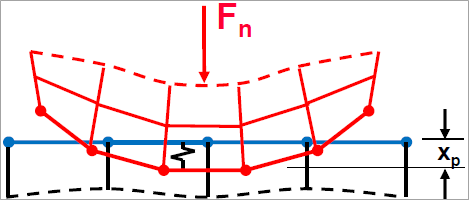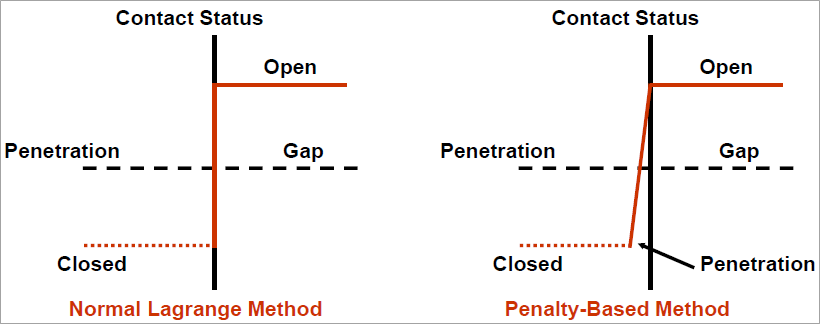Contact solutions are often very complicated. It is recommended that, whenever possible, you employ the Program Controlled setting. However, in order to better understand your selections, this section examines the specifics of Formulations.
Because contacting bodies do not interpenetrate, the application must establish a relationship between the two surfaces to prevent them from passing through each other in the analysis. When the application prevents interpenetration, it is said to enforce "contact compatibility".

In order to enforce compatibility at the contact interface, the application offers several different contact Formulations. These Formulations define the solution method used. The options for the Formulation property are listed below. For additional information, see Formulation property topic of the Advanced Settings section.
Program Controlled (default)
Pure Penalty and Augmented Lagrange Contact Formulation
For nonlinear solid body contact of faces, or formulations can be used. Both of these are penalty-based contact formulations:
FNormal = kNormalxPenetration
The finite contact Force, Fn, is a concept of contact stiffness, kNormal. The higher the contact stiffness, the lower the penetration, xp, as illustrated here.

Ideally, for an infinite kNormal, one would get zero penetration. This is not numerically possible with penalty-based methods, but as long as xp is small or negligible, the solution results are accurate.
The main difference between Pure Penalty and Augmented Lagrange methods is that Augmented Lagrange augments the contact force (pressure) calculations:
Pure Penalty: FNormal = kNormalxPenetration
Augmented Lagrange: FNormal = kNormalxPenetration + λ
Because of the extra term λ, the Augmented Lagrange method is less sensitive to the magnitude of the contact stiffness kNormal.
Normal Lagrange Contact Formulation
Another available option is Normal Lagrange. This formulation adds an extra degree of freedom (contact pressure) to satisfy contact compatibility. Consequently, instead of resolving contact force as contact stiffness and penetration, contact force (contact pressure) is solved for explicitly as an extra DOF.
FNormal = DOF
Specifications:
Enforces zero/nearly zero penetration with pressure DOF.
Does not require a normal contact stiffness (zero elastic slip)
Requires Direct Solver, which can increase computation requirements.
Normal Lagrange Chattering
Chattering is an issue which often occurs with Normal Lagrange method. If no penetration is allowed (left), then the contact status is either open or closed (a step function). This can sometimes make convergence more difficult because contact points may oscillate between an open and closed status. This is called "chattering". If some slight penetration is allowed (right), it can make it easier to converge since contact is no longer a step change.

Multi-Point Constraint (MPC) Contact Formulation
For the specific case of and Types of contact between two faces, a Multi-Point Constraint (MPC) formulation is available. MPC internally adds constraint equations to "tie" the displacements between contacting surfaces. This approach is not penalty-based or Lagrange multiplier-based. It is a direct, efficient way of relating surfaces of contact regions which are bonded. Large-deformation effects are supported with MPC-based Bonded contact.
Beam Contact Formulation
Beam Formulation is available for the Type only. This formulation works by "stitching" the contact topologies together using massless linear Beam Elements.
Comparison of Formulations
Some of the primary aspects of contact formulations are compared below.
Table 9.1: Comparing Contact Formulations
| Pure Penalty | Augmented Lagrange | Normal Lagrange | MPC | Beam |
|---|---|---|---|---|
| Good convergence behavior (few equilibrium iterations). | Additional equilibrium iterations needed if penetration is too large. | Additional equilibrium iterations needed if chattering is present. | Excellent convergence behavior (one equilibrium iteration). | |
| Sensitive to selection of normal contact stiffness. | Less sensitive to selection of normal contact stiffness. | No normal contact stiffness is required. | NA | |
| Contact penetration is present and uncontrolled. | Contact penetration is present but controlled to some degree. | Usually, penetration is near-zero. | No Penetration. | Penetration is minimal with a stiff enough material definition. |
| Useful for any type of contact behavior. | Only Bonded & No Separation behaviors. | Bonded Only | ||
| Iterative or Direct Solvers can be used. | Only Direct Solver can be Used. | Iterative or Direct Solvers can be used. | ||
| Symmetric or Asymmetric contact available. | Asymmetric contact Only. | NA | ||
| Contact detection at integration points. | Contact Detection at Nodes. | NA | ||


